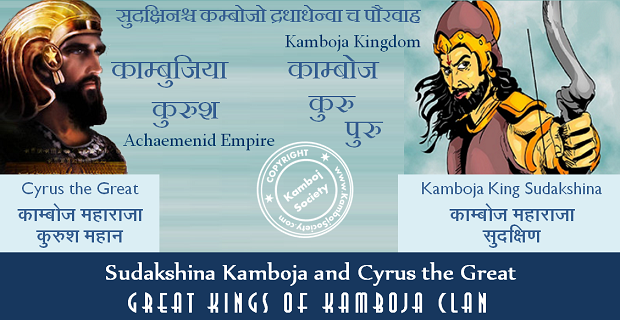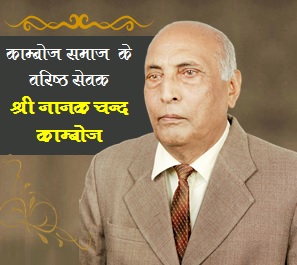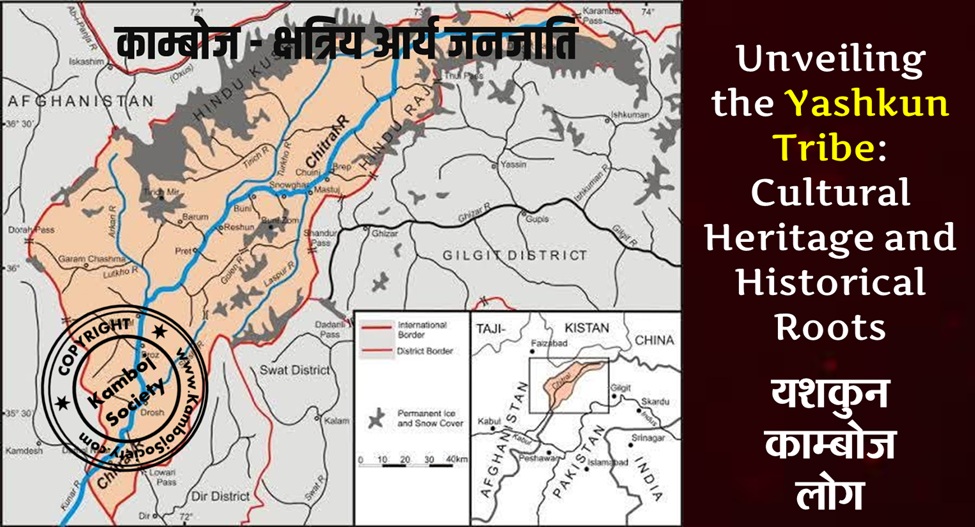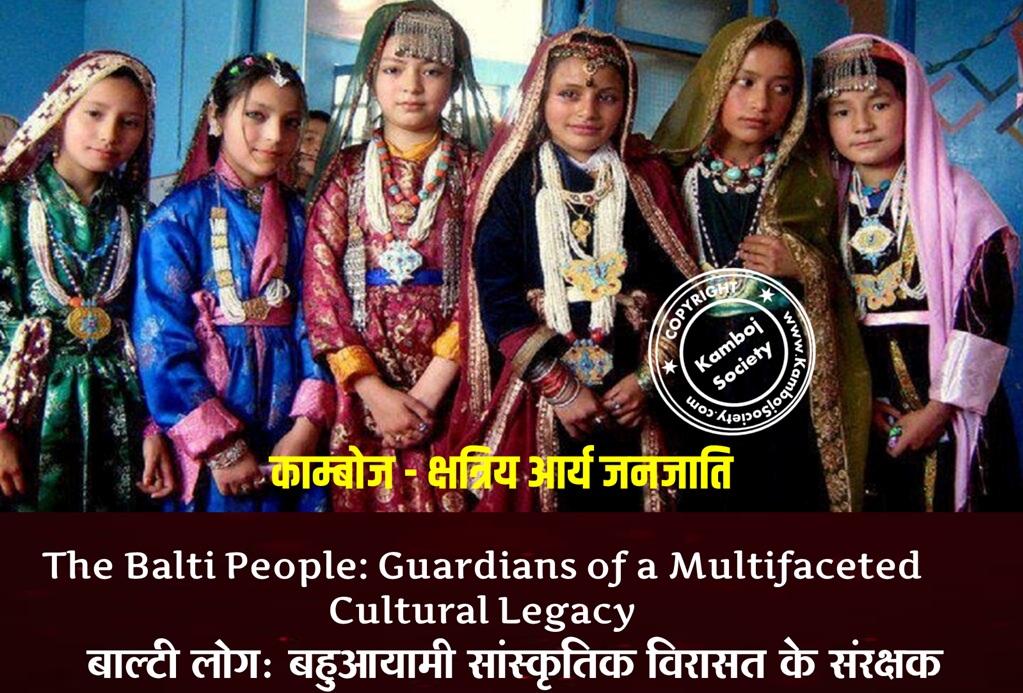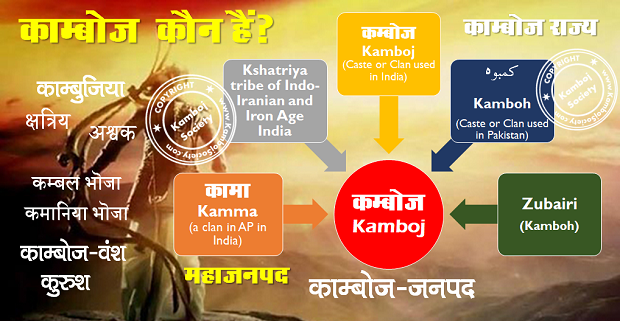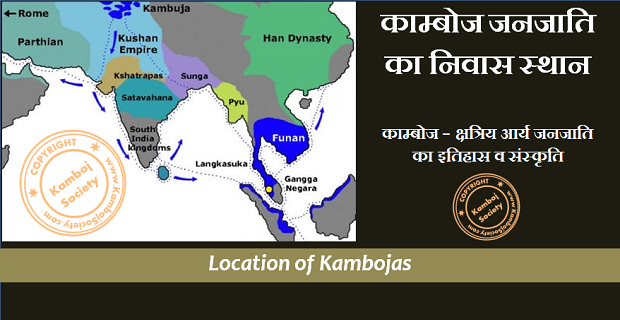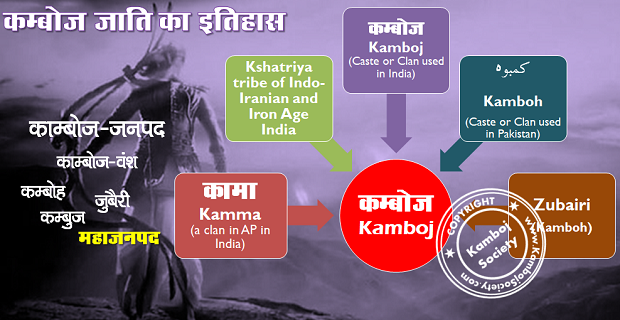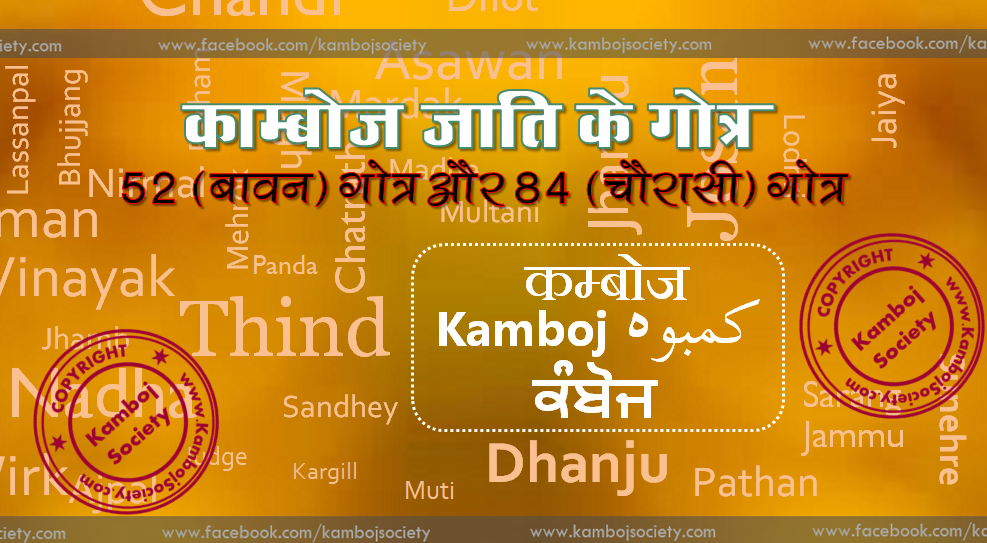The Great War of Mahabharat between the Pandavas and the Kauravas happened in 3139 BC and Kamboja King Sudakshina was one among the generals of the Kaurava army in Kurukshetra War. Kamboja King Sudakshina (काम्बोजराज सुदक्षिण) was the ruler of Kamboja Kingdom (काम्बोज साम्राज्य) and he was a great warrior (Maharathi महारथी).
Sudakshina Kamboja is mentioned to have attended Draupadi's self-choice (Swayamvara) ceremony along with the kings of neighbouring kingdoms viz Shalya, the king of Madra Kingdom, with his son, the heroic Rukmangada, Rukmaratha, Somadatta (king of Bahlika Kingdom) of the Kuru (कुरु) race with his three sons – Bhuri, Bhurisrava, and Sala.
Sudakshina Kamboja was one among the generals of the Kaurava army in Kurukshetra War (6.16.15-17),(5,155.30-33). The Kaurava generalissimo rated this car-warrior as a Ratha. Bhishma's words:- Sudhakshina, the ruler of the Kamvojas, is in my judgment, equal to a single Ratha. Desiring the success of Duryodhana's object, he will fight. As regards the car-army of this king, those smiters of fierce impetus, the Kamvojas, will cover a large area like a swarm of locusts! (5.166-1-3).
At the start of war, Vasudeva glorifies Sudakshina and lists him amongst the greatest Maharathas gathered at Kurukshetra battlefield (5.95.19-21).
Duryodhana gives a very important place to Sudakshina by placing him side by side with the greatest heroes on his side. He boasts of to Pandavas saying that his immense army has Bhishma as the current which cannot be crossed, Drona as the alligator which cannot be approached, Karna and Salya as a swarm of small fishes and the Kamboja as volcanic mouth giving out flames (5.160.40).
Duryodhana again extols the prowess of Sudakshina, along with Bhishma, Drona Acharya, Kripa Acharya, Kritvarma, Bhurisravas, Vikarna and Bhagadatta– describing them all as ‘Great Maharathas, high born, recklessly fearless, and in might and fight, more than a match even to the three worlds put together (6.65.31-33).
Karna also applauds Sudakshina as a great stalwart and includes him among the greatest generals of Bharata war, stating that Sudakshina and other select warriors were undefeatable even by the gods themselves (7.158.64-66)Sudakshina Kamboja is described as very tall, gaura- varna and extremely handsome (sudarshaniya) young prince (7.82.74). He is stated to be very fierce, brave, intelligent and illustrious warrior in the battlefield.
Sudakshina Kamboja is said to be of Puru's race (पुरु) (1.185.15)–which means he was from Kamboja clan (काम्बोज वंश) but from Puru race (Sudaksinashcha. Kambojo.drdhadhanvaa.cha. Pauravah). Some recensions of Mahabharata mention Kuru (कुरु) instead of Puru (Sudakshinashcha Kambojo dridhadhanva cha Kauravah). But since Kurus descended from the Puru race, and if Ganguli's translation of Mahabharata is indeed correct, then this implies that both the Kambojas and the Kurus had their ancestors in the Purus, and in remote antiquity, the Kurus, Purus and Kambojas may have had common ancestors from which may have off-shot the Kurus, the Kambojas as well as the Achaemenian ruling family of Persia, which had names of several of its rulers as Kurush (कुरुश), Kambujiya (or Kambaujiya)(कम्बुजिया), apparently named after the fabled heroes of Mahabharata war.Cyrus II (580-529 BC) (कुरुश, K?ruš; New Persian: ????? ???? Kurosh-e Bozorg) was the first emperor of Achaemenid Empire. He was commonly known as Cyrus the Great?and also known as Cyrus the Elder. He founded Persia by uniting the two original Iranian Tribes- the Medes and the Persians. Although he was known to be a great conqueror, who at one point controlled one of the greatest Empires ever seen, he is best remembered for his unprecedented tolerance and magnanimous attitude towards those he defeated. In 600 BC, Cyrus I was succeeded by his son, Cambyses I, who reigned until 559 BC. Cyrus the Great was a son of Cambyses I (Kamb?jia कम्बुजिया), who named his son after his father, Cyrus I. There are several inscriptions of Cyrus the Great and later kings that refer to Cambyses I as the "great king" and "king of Anshan". Among these are some passages in the Cyrus cylinder where Cyrus calls himself "son of Cambyses, great king, king of Anshan"
Illustrations:- James Hope Moulton writes: (“The names Kuru and Kamboja are of disputed etymology, but there is no reason whatever to doubt their being Aryan. I do not think there has been any suggestion more attractive than that made long ago by Spiegel[2]) that they attach themselves to Sanskrit Kura and Kamboja, originally Aryan heroes of the fable, whose names were naturally revived in a royal house. Spiegel thinks that the myths about Cyrus may have originated in confusion between the historical and the mythical heroes. (Kamboja is a geographical name, and so is Kuru often : hence their appearance in Iranian similarly to-day as Kur and Kamoj”.[3][4]
- Dr Ranajit Pal notes: (” Toynbee wrote that the Achaemenian universal state belonged also to the Hinduis, the Pathavis etc. – the Indian Kurus and Kambojas were linked with Achaemenian history–Kurush (Cyrus) was a Kuru.[5] Frye also admits that the names Kurush and Cambyses (Kambujiya)are non-Iranian.[6]
- Chandra Chakraberty writes: “The Achaemenids were Kamboja-Kuru Saka people on the base of Parsa (‘Khatti-Puru') tribe. It was a marvelous racial blend and their culture was a similar good synthesis….”[7]
- H. W. Bellew writes: “Darius succeeded, about 521 B.C to the empire founded by Cyrus (Kurush), and enlarged and consolidated by his son and successor Cambyses (Kambojia, Kambohji). Cyrus, whose mother was called Mandane (Mandana; perhaps a princess of the Mandan tribe), and said to be a Mede, and whose father was called Cambyses (Kambohji; probably a chieftain of the Kamboh tribe) having reduced the Medes and conquered the kingdom of Croesus the Lydian (Lùdi), thereby became master of all the territory extending from the Indus to the Hellespont” . –[8][9]
- Cf: “Historians tend to believe Kambojas were in fact an Iranian tribe. (Old Iranian and old Sanskrit are very close languages. All these people called themselves Aryan, from which comes the name Iran). P??ini, the Indian genius of grammar, observed (P??ini's Grammar, IV, 1, 175.) that the word Kamboja meant at the same time the tribe and its king. Later historians identified the same word in the name of several great Persian kings, Cambyse (Greek version) or Kambujiya (in Persian)[10] Cambyse the Second is famous for his conquest of Egypt (525 B.C.) and the havoc he wrought upon this country “(ON SOME CAMBODIAN WORDS, Serge Thion, [3]).
- While discussing Kambujiya of old Persian Inscriptions (Cambyses/Kambyses of the Greeks, Kamboja of the Sanskrit, or Kamoja of Kafferistan/Nuresitan), J.R.A.S. 1990 (ed) observes: “Ka(m)bujiya, Ka(n)bujiya, Kabujiya, Cambyse: This is the true vernacular orthography of name which was written Kambyses by the Greeks and Kauvays in Zend ……From the name of a king Kambyses was derived the geographical title of Kamboja (Sanskrit), which is retained to present days in the Kamoj of Cafferstan……The Persian historians do not seem to be aware of the name Kabus, which was born by the Dilemite sovereigns, is the same with the Kaus of Romance; yet the more ancient form of Kaubus or kabuj for latter name, renders the identification also most certain. The Georgians, even to the present day, name the hero of romance Kapus still retaining the labial which has merged in the Persian….”[11]
- Arnold J. Toynbee makes interesting comment on Kambojas and states that Kamboja and Kuru occur as place names in Transcaucasia (South Caucasus or South-central Eurasia) as well as on the Hindukush and in the Indian sub-continent. Interestingly, at all these three places, both Kuru and Kamboja were found to be in immediate juxtaposition. Toynbee also notes that the Kambojas and Kurus took part in the Volker Wanderung of the eighth and seventh centuries BC, and then split into two wings. He observes that these two peoples who stamped their national names on the local landscape must have been closely associated and both played some part in Achamenian history that had been auspicious as well as important[12].
- Dr Michael Witzel wrote in one of his research articles: ( “The Old Persian -s- (as in < asa ‘horse') <*?? <?v ?? with Saka -??-, while the rest of Iranian has -sp- (aspa) and Vedic has -?v- (A?va). This feature and others (cf. further grammatical features in Witzel 1989, Ch 10) may point to an ultimately north-eastern (Bactria?) rather than north-western (Urartu/Median) origin of the Old Persian and thus to a track of immigration from the North-east via Media to the Persis, somewhat like Nichols' (1997–98) ‘southern trajectory'. A North-eastern origin would be close to the location of the Vedic Par?u” ).
- COMMENT: Dr Michael Witzel seems to convey here that the Persians may have migrated to Persipolis from Balkh or Bactria in remote antiquity. This is quite a valid and scientific reasoning as the above extract from Dr Michael Witzel (Harvard University) seems to show. This shows that the Parsa Achaemeninas may have been off-shoots from the Kambojas of Badakshan/Bactria but in remote antiquity. The remote connections of the Achaemenids to the Kambojas and Kurus is indeed reflected in the royal name Kuru and Kambujiya/Kambaujiya which several of the great monarchs of the Achamenean line of rulers had adopted.
- (Seeing close connections of the Kambojas (Parama-Kambojas), the Madras (Bahlika-Madras or Uttaramadras) and the Kurus (Uttarakurus) which tribes were all located in/around Oxus in Central Asia in remote antiquity, it can be thought that the Kurus, the Kambojas and the Par?us were a related people).
- cf: Blending with the nearest black-haired tribes, the ancestors of the Kamoges of Hindukush are believed to have given rise to ancient Persians and with the faired-haired on the north, they are said to have produced the handsome tribes of the Goths. The name Kamoges or Kamojis apparently reminds one of the ancient Kambojas living in Hindukush, Pamirs as well as in Badakshan. (See: Kamboja Location). The modern Kamboj or Kamboh people of northern India are stated to have descended from the ancient Kambojas and are believed to belong to the same ancient stock as the Kamoges or Kamojis of Hindukush.[13]
- The tribal name Kamboja has been traced to the royal name Kambujiya of the Old Persian Inscriptions (known as Cambyses to the Greeks. This view is held by numerous scholars like C. Lassen, S. Levi, M. Witzel, J. Charpentier, La Valle Poussin, A. Hoffman, A. B. Keith, A. A. Macdonell, G. K. Nariman, E. Kuhn, H. W. Bellew, A. D. Pusalkar, S. Sen, D. R. Bhandarker, H. W. Bailey, Spiegel and numerous others.


